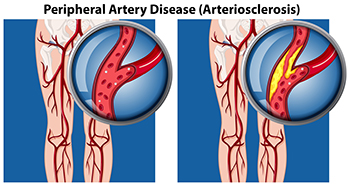
Foot pain is more than just an annoyance. It can signal a potential threat to your overall health. One such condition linked to foot discomfort is peripheral artery disease, abbreviated PAD, and is a serious condition that, if left untreated, can have fatal consequences. PAD occurs when fatty deposits accumulate in the arteries, restricting blood flow to the leg muscles. This condition is not to be taken lightly, as it often leads to more severe complications, such as coronary heart disease and an increased risk of strokes. Recognizing the signs of PAD early on is essential for effective treatment and prevention of further complications. The primary indicators of peripheral artery disease are recurring leg pain during exercise, foot pain, persistent ulcers, and the development of gangrene. Foot pain, ranging from mild to severe, is a common symptom that typically subsides with rest. If you notice open sores, known as ulcers, on your feet or legs that do not heal, it is essential to consult with your podiatrist promptly. Gangrene, a severe condition characterized by swelling, pain, and the production of foul-smelling pus, can occur when PAD progresses. Skin changes, such as coldness, numbness, and discoloration, may also manifest. If you are experiencing symptoms of peripheral artery disease in the feet and ankles, it is suggested that you schedule an appointment with a podiatrist for treatment.
Peripheral artery disease can pose a serious risk to your health. It can increase the risk of stroke and heart attack. If you have symptoms of peripheral artery disease, consult with Dan Kirk, DPM from Bluffton Foot & Ankle. Our doctor will assess your condition and provide you with quality foot and ankle treatment.
Peripheral artery disease (PAD) is when arteries are constricted due to plaque (fatty deposits) build-up. This results in less blood flow to the legs and other extremities. The main cause of PAD is atherosclerosis, in which plaque builds up in the arteries.
Symptoms
Symptoms of PAD include:
- Claudication (leg pain from walking)
- Numbness in legs
- Decrease in growth of leg hair and toenails
- Paleness of the skin
- Erectile dysfunction
- Sores and wounds on legs and feet that won’t heal
- Coldness in one leg
It is important to note that a majority of individuals never show any symptoms of PAD.
Diagnosis
While PAD occurs in the legs and arteries, Podiatrists can diagnose PAD. Podiatrists utilize a test called an ankle-brachial index (ABI). An ABI test compares blood pressure in your arm to you ankle to see if any abnormality occurs. Ultrasound and imaging devices may also be used.
Treatment
Fortunately, lifestyle changes such as maintaining a healthy diet, exercising, managing cholesterol and blood sugar levels, and quitting smoking, can all treat PAD. Medications that prevent clots from occurring can be prescribed. Finally, in some cases, surgery may be recommended.
If you have any questions, please feel free to contact our offices located in Bluffton and Celina, OH . We offer the newest diagnostic and treatment technologies for all your foot care needs.
